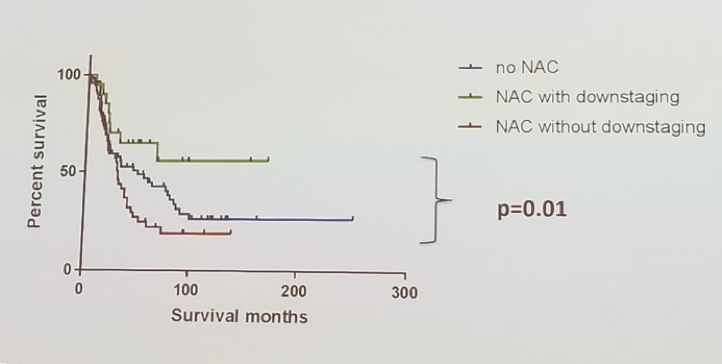Micropapillary urothelial carcinoma (MPUC) is a known aggressive variant of bladder cancer. The role of NAC in the treatment of this histologic variant is not well defined. There are 3 proposed MPUC clinical risk groups:
- Lower risk – Clinical T1, no hydronephrosis
- High risk – >= clinical T2, no hydronephrosis
- Highest risk – any clinical T stage, hydronephrosis
The authors identified 150 patients who underwent radical cystectomy between 2000 and 2017 with MPUC in a single institution. All clinical and pathologic data were collected. The patient cohort is demonstrated in Table 1, and the NAC regimen is shown in table 2 (Mean number of treatment cycles was 4.67 (+/-1.5).
Table 1 – Patient cohort:

Table 2 – Neoadjuvant chemotherapy regimen:

The results demonstrated no significant difference in overall survival (OS) when comparing patients who received and didn’t receive NAC (Figure 1).
Figure 1 – Difference in overall survival among patients who received and did not receive neoadjuvant chemotherapy:

No difference was demonstrated when patients were stratified to lowest and highest risk patients, although a difference was demonstrated in the high-risk patients (Figure 2). Pathological down-staging did also show a difference in OS (Figure 3).
Figure 2- Different in overall survival in high-risk patients:

Figure 3 – Effect of Down-staging on overall survival:

Summarizing this presentation, Dr. Duplisea stated that NAC appears to benefit only high-risk patients. Although pathological down-staging occurred with NAC use, it did not translate into a survival benefit when considering all patients.
Presented by: Jonathan Duplisea, MD Anderson Cancer Center, Houston, United States
Written by: Hanan Goldberg, MD, Urologic Oncology Fellow (SUO), University of Toronto, Princess Margaret Cancer Centre, Twitter: @GoldbergHanan at the 73rd Canadian Urological Association Annual Meeting - June 23 - 26, 2018 - Halifax, Nova Scotia


